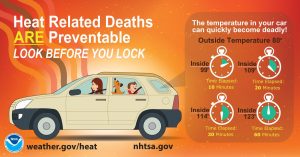
Today: Mostly sunny this morning; P/Cldy this afternoon. High 89. S @ 10-20 mph.
Tonight: Fair to Partly cloudy. Low around 67. S @ 5-10.
Tomorrow: Mostly sunny in the morning; P/Cldy during the afternoon. High near 90. S @ 10-20.
Thursday: P/Cldy. High 91.
Friday: P/Cldy to cldy w/scattered showers & thunderstorms. High around 84.
Monday’s High in Atlantic was 90. Our Low this morning, 64. Last year on this date, the High was 92 and the Low was 71. The Record High was 102 in 1985, and the Record Low was 38 in 1930.
Today: Mostly sunny this morning; P/Cldy this afternoon. High 88. S @ 10-20 mph.
Tonight: Fair to Partly cloudy. Low around 66. S @ 5-10.
Tomorrow: Mostly sunny in the morning; P/Cldy during the afternoon. High near 88. S @ 10-20.
Wednesday: P/Cldy. High around 89.
Thursday: P/Cldy. High near 90.
Sunday’s High in Atlantic was 84. Our Low was 66. Last year on this date, the High was 93 and the Low was 75. The Record High was 98 in 1984 & 2011, and the Record Low was 36 in 1894.
Today: Mostly sunny, with a high near 86. Breezy, with a south wind 8 to 18 mph, with gusts as high as 24 mph.
Tonight: Partly cloudy, with a low around 65. South wind 7 to 14 mph, with gusts as high as 20 mph.
Monday: Mostly sunny, with a high near 88. South wind 7 to 11 mph, with gusts as high as 20 mph.
Monday Night: Mostly clear, with a low around 65. South southeast wind 5 to 10 mph.
Tuesday: A 20 percent chance of showers and thunderstorms after 1pm. Sunny, with a high near 90. South southeast wind 3 to 8 mph.
Tuesday Night: Mostly clear, with a low around 68.
Wednesday: A 20 percent chance of showers and thunderstorms after 1pm. Sunny, with a high near 92.
Saturday’s High in Atlantic was 91. Our Low was 65. Last year on this date, the High was 91 and the Low was 71. The Record High was 103 in 1933, and the Record Low was 32 in 1894.
Today: Partly-to Mostly Sunny. High 92. Southwest winds 10-20 mph.
Tonight: Fair-to Partly Cloudy. Low around 55. South @ 5 mph.
Tomorrow: P/Cldy & breezy. High around 89. S @ 10-20.
Monday & Tuesday: P/Cldy w/isolated showers & thunderstorms possible. Highs both days near 87.
Friday’s High in Atlantic was 91. Our Low was 65. Last year on this date, the High was 94 and the Low was 69. The Record High was 104in 1933, and the Record Low was 40 in 1897 & 1935.
Today: Partly-to Mostly Sunny, with a high near 90. Southwest winds 10-20 mph.
Tonight: Fair-to Partly Cloudy. Low around 64. South @ 5-10 mph.
Tomorrow: P/Cldy & breezy. High near 90. SW @ 10-20 w/gusts to near 30 at times.
Sunday: P/Cldy. High near 87.
Monday: P/cldy to Cldy w/isolated showers & thunderstorms possible. High near 87.
Thursday’s High in Atlantic was 86. Our Low was 53. Last year on this date, the High was 91 and the Low was 68. The Record High was 96 in 1914, and the Record Low was 31 in 1945.
Officials with the U-S Army Corps of Engineers, Thursday, said the forecast for the flow of the Missouri River hasn’t changed all that much from last month, with much less water coming downstream due to dry conditions and below normal snowpack levels.
The Corps says only about 69% of the normal amount of water is expected to flow into the Missouri River this year, which would be the 22nd driest year in the upper basin since 1898. Two-years ago, historic flooding along the Missouri River ravaged parts of Nebraska, Iowa, Kansas and Missouri.
(Radio Iowa) – The weather experts say La Nina is gone. The weather pattern resulting from the cooling of the Pacific Ocean’s surface has an impact on the weather across North America, and it’s now completely faded away. Doug Kluck, regional climate service director for the National Weather Service, says even with this latest heat wave, temperatures normalized in Iowa and across the Midwest as La Nina disappeared.
“It is, for the most part gone,” Kluck says. “I think temperatures remain slightly cooler than normal but they’re trending toward what they are in our classification system — basically neutral — so, neither El Nino nor La Nina.” Historically, La Ninas have caused below-normal temperatures across much of the Northern Plains states. An El Nino can bring weather extremes, including severe drought or severe flooding. Kluck says La Nina may reappear later this year, but it will take a few months to sort that out.
“There are some indications from models that we could slip back into La Nina, which would not be unprecedented by any means,” Kluck says. “A couple years in a row of La Nina isn’t out of the question but it’s too early to call that now. In about two months, we should have a better handle on that.” Kluck says a swing toward El Nino, a warming of the surface temperatures, is not likely in the next year.
(Radio Iowa) – Eastern Iowa had frost warnings with low temperatures in the 30s just last week, but summer-like weather is settling in now, as forecasters say highs will climb into the 80s and 90s over the next few days. Today (Thursday) is Heat Awareness Day and meteorologist Jim Lee, at the National Weather Service in Johnston, says it’s a reminder of the hazards of hot weather. “Anytime we see high levels of heat and humidity here in the summer, which is fairly common especially as we get toward the dog days of summer,” Lee says, “anytime anybody’s working outside, they need to be aware that time in the sun and time of physical exertion can lead to heat stress syndrome.”

 Parents and anyone who cares for kids also need to be reminded about the dangers of these quickly escalating temperatures. “We see multiple times per year, children who die left unattended in vehicles,” Lee says. “It is very important to never leave your child in a vehicle unattended for any length of time and also to be aware of who’s in the back seat and, as they say, look before you lock.” It’s a coincidence this Heat Awareness Day arrives precisely as the forecast calls for a heat wave. “We are looking at the warmest weather of the season so far coming over the next multiple days and through the weekend,” Lee says. “It’s more important now than ever to make sure you take your heat health seriously. If you’re outside this weekend, drink plenty of fluids and take some breaks in the shade.”
Parents and anyone who cares for kids also need to be reminded about the dangers of these quickly escalating temperatures. “We see multiple times per year, children who die left unattended in vehicles,” Lee says. “It is very important to never leave your child in a vehicle unattended for any length of time and also to be aware of who’s in the back seat and, as they say, look before you lock.” It’s a coincidence this Heat Awareness Day arrives precisely as the forecast calls for a heat wave. “We are looking at the warmest weather of the season so far coming over the next multiple days and through the weekend,” Lee says. “It’s more important now than ever to make sure you take your heat health seriously. If you’re outside this weekend, drink plenty of fluids and take some breaks in the shade.”
Summer officially arrives on June 20th. Find more information about Heat Awareness Day at www.weather.gov/dmx.
Today: Partly cloudy. High 85. SW @ 10-15.
Tonight: Fair to P/Cldy. Low 58. Winds light & variable.
Tomorrow: P/Cldy. High 88. SW @ 10-20.
Saturday: P/Cloudy. High near 90..
Sunday: P/Cldy. High again near 90.
Wednesday’s High in Atlantic was 83. Our Low this morning, 49. Last year on this date the High in Atlantic was 94 and the Low was 68. The Record High on this date was 94 in 2020. The Record Low was 32 in 1969.
(Radio Iowa) – Forecasters say Iowa’s rollercoaster weather will see temperatures rocket back into the 80s and 90s this week after frosty lows dropped into the 30s just last week. The return to summery heat means more worries about drought as the recent rains weren’t enough to reverse months of dry weather. Adam Hartman, a meteorologist with the Climate Prediction Center, says the ground remains very arid, despite several downpours. “When you have heavy rainfall in a very short period of time, it doesn’t allow the soils enough time to absorb that moisture,” Hartman says, “Instead you actually get more runoff than absorption.”
The drought started last summer and the latest U-S Drought Monitor map shows most of Iowa remains in the categories of abnormally dry, moderate drought or extreme drought. Meteorologist Dennis Todey, director of the U-S-D-A’s Midwest Climate Hub in Ames, says even with the May rains, there just isn’t enough moisture in the soil for plants to thrive. “We are at greater risk of having problems with crops and other plants as the season goes along,” Todey says, “because there’s not as much moisture available for the crops to be able to grow.”
It’s hard to say how long the drought will continue, as summer often brings localized thunderstorms which can be difficult to forecast. Todey says long-term drought could create problems for water quality in Iowa. The amount of water flowing in the Raccoon River, the main source of drinking water for Iowa’s largest city, dropped down about 90-percent from normal during May.
(reporting by Katie Peikes, Iowa Public Radio)